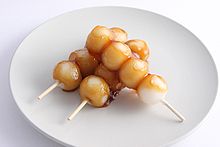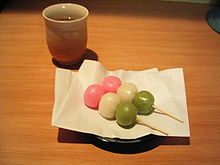- Dango
-
Dango (団子) is a Japanese dumpling made from mochiko (rice flour), related to mochi. It is often served with green tea.
Dango are eaten year-round, but the different varieties are traditionally eaten in given seasons. Three to four dango are often served on a skewer.
Contents
Types of dango
There are many different varieties of dango which are usually named after the various seasonings served on or with it. [1]
- Anko: Commonly known as (sweetened) red bean paste, while ingredients other than azuki are used on rare occasions.
- Chadango: Green-tea flavored Dango.[1]
- Bocchan dango: Dango that has three colors. One is colored by red beans, the second by eggs, and the third by green tea.
- Denpun dango: Variety of dango from Hokkaidō made from potato flour and baked with sweet boiled beans
- Kuri dango: Dango coated in chestnut paste
- Chichi dango: Slightly-sweet light treats usually eaten as a dessert.
- Hanami dango: Also has three colors, Hanami dango is traditionally made during Sakura-viewing season. Hence the name Hanami (Hanami means "flower viewing"; hana meaning "flower", and mi meaning "to see").
- Goma: sesame seeds. It is both sweet and salty.
- Kibi dango: Dango made with millet flour.
- Kinako: A toasted soy flour.
- Kushi dango: Dango held by a skewer
- Mitarashi: Covered with a syrup made from shouyu (soy sauce), sugar and starch.
- Nikudango A type of meatball.[2]
- Teppanyaki: Dango on a skewer with a tangy teppanyaki taste.
- Sasa dango: Dango that is produced and eaten primarily in Niigata Prefecture. Sasa dango has two varieties: "Onna Dango" and "Otoko Dango." Onna Dango (literally "Female Dango") is filled with anko, while the otoko dango (literally "Male Dango") is filled with kinpira. The dango is wrapped in leaves of sasa for the purpose of preservation.
Derived terms
A common Japanese proverb “Hana yori dango” (花より団子, literally, “dumplings rather than flowers”) refers to a preference for practical things rather than aesthetics.
Dango is used internationally amongst go players as a derogatory term for an inefficient, dumpling-like cluster of stones in a go game. It is also the name of a go variant invented in 1991.
A hairstyle consisting of dango-like buns on either side of the head is sometimes known as odango.
See also
- Wagashi, traditional Japanese confectionery
References
- ^ "Wagashi: Chadango and Minazuki". June 29, 2008. http://kyotofoodie.com/wagashi-chadango-minazuki/. Retrieved 2009-03-28.
American cuisine Latin AmericaAsian cuisine East AsiaChinese: Baozi · Ci fan tuan · Dim sum · Fun guo · Har gow · Hujiao bing · Jau gok · Jiaozi · Lo mai gai · Shengjian mantou · Shumai · Siopao · Suanla chaoshou · Tang bao · Tangyan · Taro dumpling · Wonton · Xiaolongbao · Zhaliang · Zongzi · Other: Akashiyaki · Buuz · Dango · Khuushuur · Mandu · Mandugwa · Manduguk · Mitarashi dango · MomoSouth East AsiaVietnamese: Ba-wan · Bánh bao · Bánh chưng · Bánh lá · Bánh tẻ · Bánh tét · Other: Caozai Guo · Kueh tutu · Kuih kochi · NagasariWest AsiaNorth AsiaEuropean cuisine Bryndzové halušky · Halušky · Kalduny (Kundumy) · Kopytka · Pierogi · Scovardă · Shlishkes · Strapačky · Uszka · VarenykySouthern EuropeCentral EuropeCapuns · Kluski · Knedle · Knödel · Maultasche · Mohnnudel · Pickert · Schupfnudel · Silesian dumplingsWestern EuropeNorthern EuropeOther AustraliaCategories:- Japanese words and phrases
- Japanese cuisine
- Wagashi
- Dumplings
- Skewered foods
Wikimedia Foundation. 2010.



